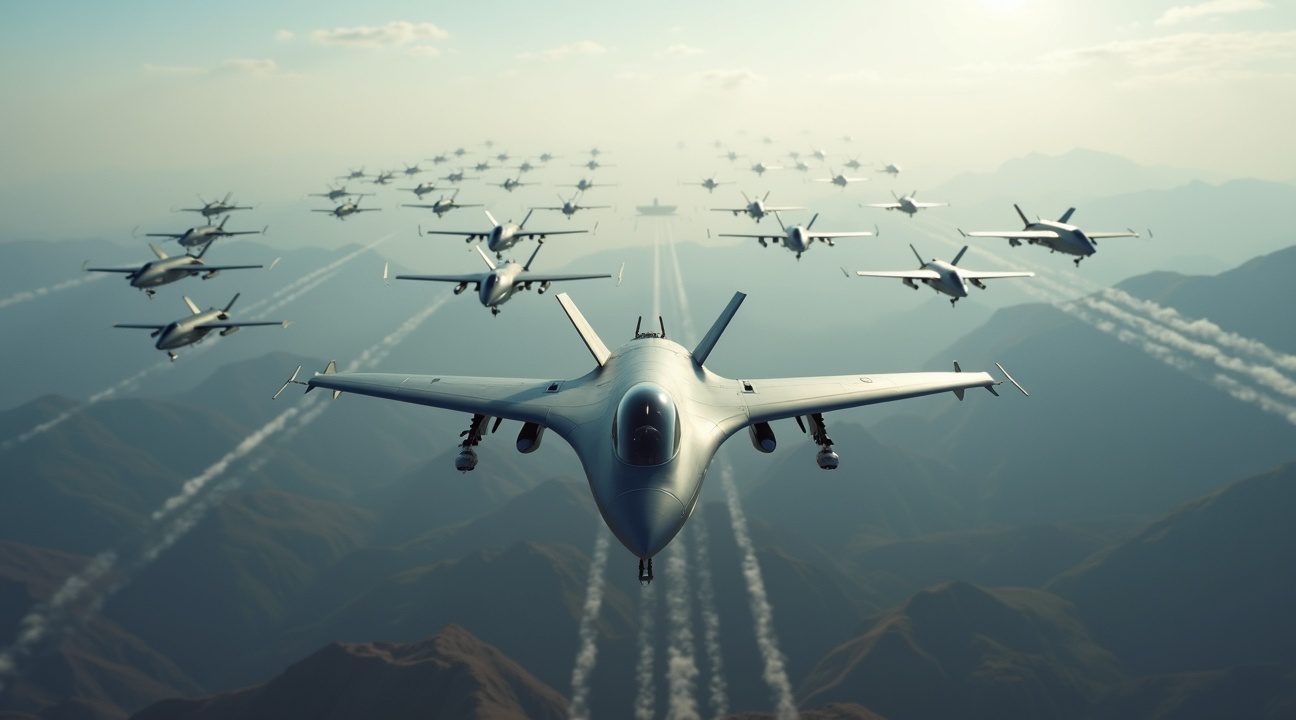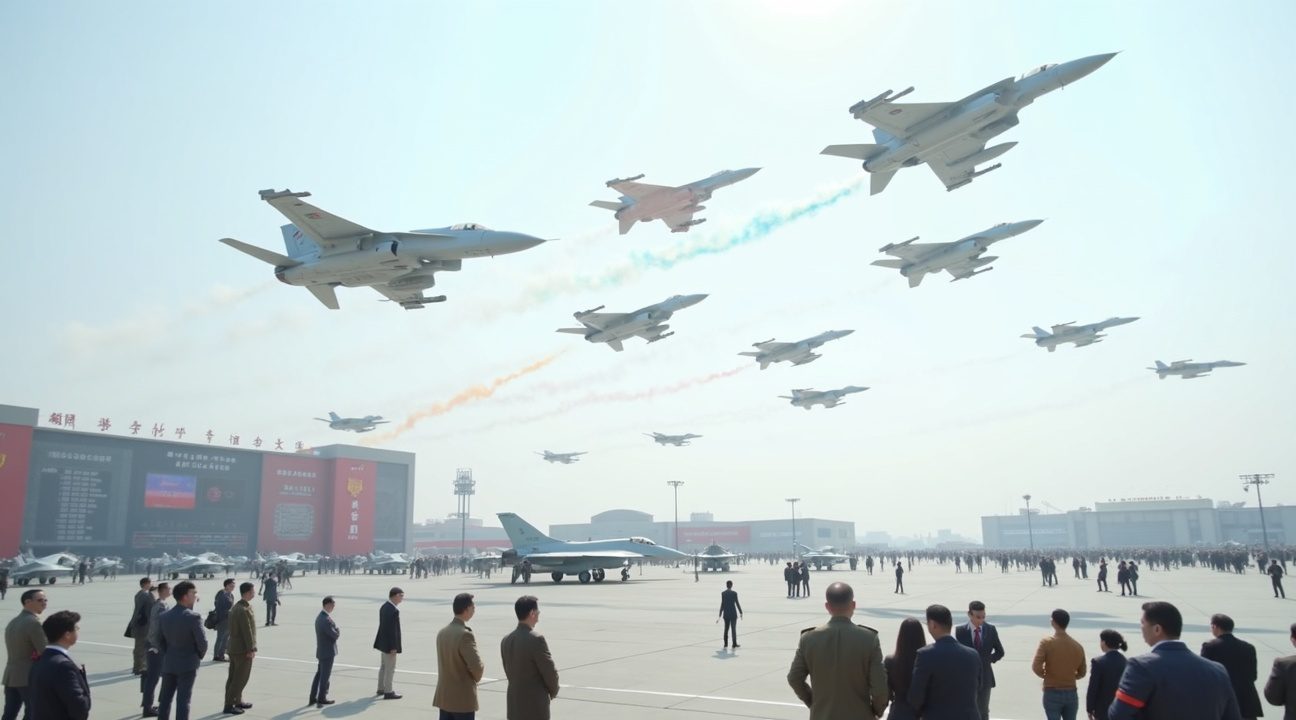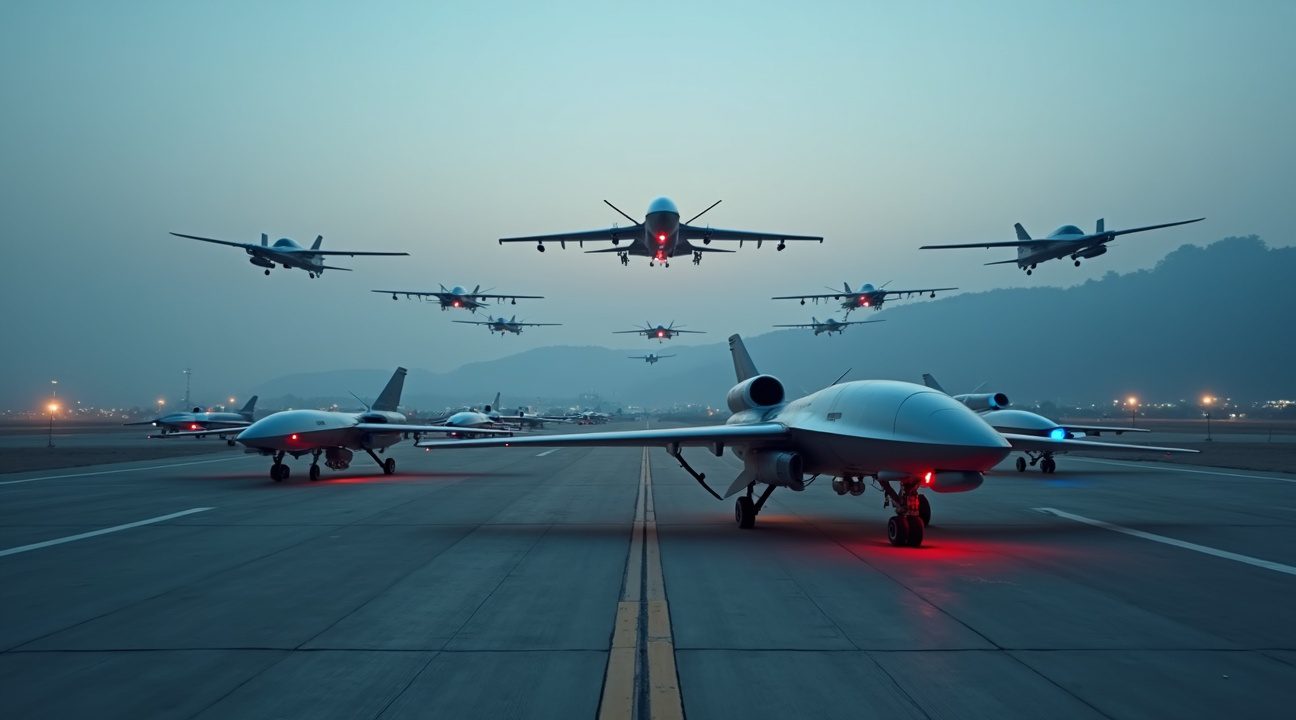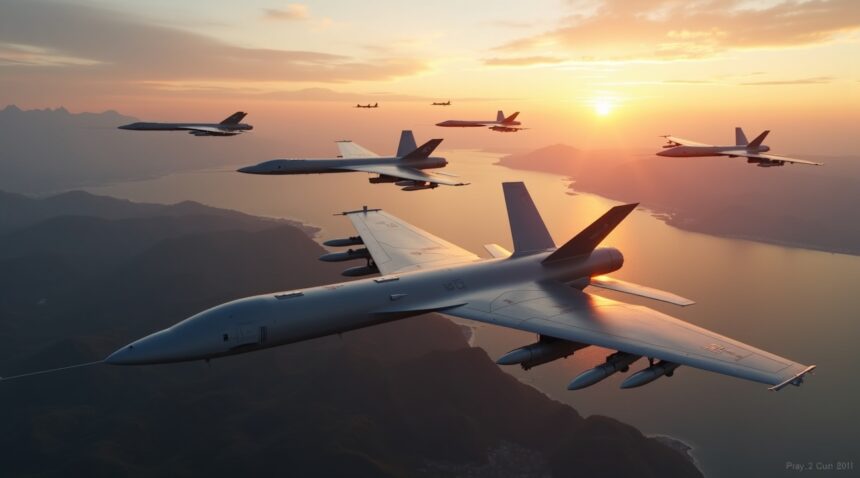China’s ambitious military modernization program is transforming the face of aerial warfare by converting thousands of retired fighter jets into state-of-the-art unmanned systems.
China’s J-6 Drone Conversion Program
China has initiated a significant military upgrade by converting up to 3,000 retired J-6 fighter jets into autonomous combat drones. These retrofitted aircraft are equipped with 250 kg of munitions and are capable of executing autonomous strike missions. Originally Soviet-designed and Cold War-era in origin, the J-6 has been repurposed to serve in modern swarming attacks as expendable drone platforms.
This groundbreaking initiative was kept under wraps from its inception in 1995 until its public unveiling at the 2025 Changchun Air Show. This revelation showcased China’s long-term investment in asymmetric military capabilities and aerial innovation.
Key Takeaways
- China has retrofitted 3,000 retired J-6 fighter jets into autonomous drones, each capable of carrying 250 kg of munitions. This marks one of the largest drone fleets assembled from existing military assets.
- The converted drones retain supersonic speeds (Mach 1.3) and can operate within a range of 700 km, providing superior capabilities compared to standard reconnaissance or commercial drones.
- This strategy emphasizes cost-effectiveness by upgrading decommissioned aircraft, thereby reducing the need to invest in entirely new platforms.
- The swarm tactics employed are intended to overwhelm air defenses, particularly targeting Taiwan’s systems with sheer quantity and autonomous coordination, creating a lopsided cost-efficiency in China’s favor.
- The program exemplifies China’s patience and strategic foresight, having evolved from classified test flights in 1995 to a major public display nearly 30 years later.
Conclusion
China’s J-6 conversion project highlights a unique fusion of legacy technology with modern warfare doctrine. By rejuvenating outdated aircraft and channeling them into a coordinated, expendable drone network, China bolsters its military presence and illustrates a growing reliance on cost-effective, autonomous strike capabilities.
How 3,000 Soviet-Designed Jets Are Being Transformed Into a Modern Drone Army
China’s ambitious conversion program transforms retired J-6 fighter jets, originally based on the Soviet MiG-19 design, into unmanned combat aerial vehicles that represent a significant shift in modern warfare strategy. The scale of this undertaking involves up to 3,000 aircraft being retrofitted as expendable platforms, each capable of carrying 250 kg of munitions while maintaining the original aircraft’s impressive performance characteristics.
Technical Capabilities and Performance Specifications
The converted J-6 maintains its original supersonic capabilities, achieving speeds of Mach 1.3 (1,600 km/h or 995 mph) while operating as an unmanned platform. This speed advantage distinguishes these drones from typical slower-moving UAVs, creating new tactical possibilities for rapid strike missions. The aircraft’s combat range of 700 km (435 miles) provides substantial operational reach, while additional hardpoints accommodate various payloads including bombs, decoys, or electronic warfare pods beyond the standard 250 kg munition capacity.
The J-6W variant, as the converted version is designated, leverages the robust airframe of the original second-generation supersonic fighter. Engineers have integrated modern control systems while preserving the aircraft’s proven aerodynamic design and structural integrity. This approach maximizes the value of existing military assets rather than retiring them completely.
China’s revolutionary drone technology development includes these converted platforms as part of a broader strategy emphasizing swarm attacks and coordinated operations. The concept treats each converted J-6 as an expendable platform, fundamentally different from expensive modern fighter aircraft that require careful preservation.
As of April 2022, approximately 580 J-6W units were already operational, with conversions continuing across China’s extensive inventory of retired fighters. This timeline suggests a systematic approach to the conversion process, likely involving specialized facilities dedicated to the retrofit work.
The strategic implications of this drone army extend beyond simple force multiplication. These platforms can:
- Overwhelm air defense systems through coordinated swarm attacks
- Operate in high-risk environments without risking pilot lives
- Provide cost-effective solutions for various mission profiles
The combination of supersonic speed, substantial payload capacity, and expendable nature creates new tactical possibilities that traditional drones cannot match.
Military technology advancements like this conversion program demonstrate how older platforms can gain new relevance through modern upgrades. The J-6 drone conversion represents a practical application of existing resources, transforming Cold War-era assets into contemporary combat tools that complement China’s evolving military strategy while providing significant operational flexibility across diverse mission requirements.

Taiwan’s Air Defenses Face an Unprecedented Swarm Challenge
I observe that China’s conversion of 3,000 J-6 fighters into weaponized drones represents a calculated strategy to overwhelm Taiwan’s air defense systems through sheer numbers and coordinated attacks. The converted J-6 drones serve a specific tactical purpose: saturating enemy defenses with targets that are significantly more challenging to intercept than typical commercial drones.
These Cold War-era aircraft, now transformed into autonomous weapons platforms, present unique advantages in swarm tactics. Their substantial airframes and high-speed capabilities make them formidable adversaries for missile defense systems designed to handle smaller, slower targets. Unlike compact commercial drones that might evade detection, the J-6’s larger radar signature paradoxically becomes an asset when deployed in massive coordinated strikes.
Strategic Positioning and Operational Range
The geographic positioning of airfields in Fujian Province provides China with a critical advantage in any potential Taiwan Strait scenario. These bases position the converted drones within operational range of Taiwan, eliminating concerns about fuel capacity or extended flight times that might affect mission success. The proximity factor transforms these drones into immediate tactical threats rather than strategic assets requiring complex logistics.
Saturation attacks using these drone swarms follow a deliberate military doctrine focused on overwhelming defensive capabilities. Defense analysts recognize that Taiwan’s missile defense systems, while sophisticated, maintain finite ammunition stocks. Each interceptor missile costs significantly more than a converted J-6 drone, creating an unfavorable economic exchange ratio for defenders.
The tactical approach emphasizes exhausting enemy missile inventories through repeated waves of drone attacks. Initial strikes probe defensive positions and force radar installations to reveal their locations. Follow-up waves then target these exposed radar sites, systematically degrading Taiwan’s ability to detect and track subsequent attacks.
Military strategists understand that drone saturation represents a force multiplier effect. Traditional air defense calculations become obsolete when facing hundreds or thousands of simultaneous targets. Command and control systems struggle to prioritize threats when every incoming drone carries substantial explosive payloads.
The converted J-6 platforms carry approximately 250 kilograms of munitions, providing sufficient destructive capability to damage critical infrastructure or military installations. This payload capacity distinguishes them from reconnaissance drones or smaller attack variants, positioning them as genuine weapons systems rather than mere surveillance tools.
Advanced military technology integration with these legacy airframes demonstrates China’s commitment to maximizing existing resources while developing asymmetric warfare capabilities. The conversion process essentially creates expendable strike platforms that combine the speed and payload capacity of fighter aircraft with the expendability of unmanned systems.
From Cold War Fighter to Modern Kamikaze: The Technical Transformation
I find the transformation of China’s J-6 fighter jets into unmanned combat aerial vehicles to be one of the most fascinating examples of military repurposing in recent years. Originally manufactured between the 1960s and 1980s, these aircraft served as the backbone of China’s air force with over 4,500 units produced. After their retirement in the 1990s, thousands sat in storage facilities across the country, seemingly destined for scrap yards or museums.
The technical metamorphosis of these legacy aircraft involves extensive modifications that strip away their manned operational systems. Engineers remove cockpits, cannons, and ejection seats to create space for new autonomous systems. This process fundamentally alters the aircraft’s internal architecture while maintaining its basic airframe and flight characteristics. The transformation demonstrates how China develops revolutionary drone technology by leveraging existing military assets rather than building entirely new platforms.
Digital Integration and Autonomous Capabilities
The modernization process centers on installing sophisticated digital autopilots that enable autonomous flight operations. These systems incorporate terrain-matching capabilities that allow the converted drones to navigate complex geographical features without human intervention. Advanced navigation systems replace the original analog instruments, providing precise positioning and flight path management. The integration of these modern components with decades-old airframes requires careful engineering to ensure compatibility between new digital systems and existing mechanical structures.
Engineers outfit these converted aircraft with flexible operational programming that supports multiple mission profiles. The drones can:
- Function as traditional strike aircraft for precision attacks
- Operate as kamikaze drones for single-use missions
- Serve as decoy systems to confuse enemy radar networks
- Act as training targets for air defense exercises
This versatility makes each converted aircraft a multi-purpose asset that commanders can deploy based on specific tactical requirements.
What I find particularly intriguing about this conversion program is how the J-6’s analog-based avionics actually provide an unexpected advantage in modern warfare. Unlike contemporary aircraft that rely heavily on digital systems, these older platforms possess inherent electronic warfare resistance. Modern military forces typically design their jamming and cyber warfare capabilities to target advanced digital systems, making the J-6’s simpler analog components less vulnerable to such attacks. This characteristic transforms what might seem like a technological disadvantage into a strategic asset.
The legacy aircraft integration process demonstrates how military planners can breathe new life into retired equipment through innovative engineering approaches. Rather than investing billions in developing entirely new drone platforms, China has created a cost-effective solution that leverages existing infrastructure and manufacturing knowledge. The military technology advancements in 2023 show similar trends across various nations seeking efficient ways to modernize their capabilities.
The kamikaze drone configuration represents perhaps the most dramatic departure from the aircraft’s original fighter role. These units carry approximately 250 kilograms of munitions and are programmed for one-way missions against high-value targets. The autonomous navigation systems guide them to their destinations with minimal external communication, reducing the risk of interception or detection by enemy forces.
The technical transformation also addresses logistical considerations that make these converted aircraft particularly attractive for military planners. Maintenance requirements remain relatively straightforward since the basic airframe and engine systems haven’t fundamentally changed. Ground crews familiar with the original J-6 can adapt their skills to support the unmanned variants with additional training on the new digital components.
This conversion program illustrates how artificial intelligence paving the way for the future intersects with traditional military hardware. The autonomous flight systems rely on AI algorithms to process sensor data and make real-time navigation decisions, creating a hybrid platform that combines Cold War-era engineering with 21st-century intelligence capabilities.
Why Converting Old Jets Makes Economic and Strategic Sense
Cost-Effective Resource Utilization
China’s strategy of converting retired fighter jets into unmanned combat aerial vehicles demonstrates remarkable fiscal efficiency in modern warfare planning. Rather than designing and manufacturing entirely new drone platforms from scratch, this approach leverages existing airframes that have already served their primary mission. The transformation process costs significantly less than developing new UCAVs while providing immediate capability enhancement.
Military analyst Song Zhongping has identified kamikaze drones as the most straightforward and budget-friendly application for these converted aircraft. Simple modifications can transform a retired fighter into an effective strike platform, requiring minimal technological upgrades compared to more sophisticated reconnaissance variants. This revolutionary drone technology approach maximizes return on previous defense investments.
Strategic Alignment with Modern Warfare Doctrine
The conversion strategy aligns perfectly with the People’s Liberation Army’s doctrine of maximizing sunk costs while advancing military capabilities. By repurposing thousands of aircraft that might otherwise sit idle or face expensive disposal, China creates an attritable platform that commanders can deploy without concern for recovery or preservation.
This methodology supports China’s evolving ‘mosaic warfare’ tactics, which emphasize the integration of older platforms with cutting-edge systems like the stealth-capable GJ-11. The converted jets serve as low-cost mass production solutions that complement more expensive, sophisticated drones. Military strategists recognize that quantity has its own quality – swarms of converted aircraft can overwhelm defensive systems through sheer numbers while preserving more valuable assets for critical missions.
The economic advantages extend beyond initial conversion costs:
- Minimal maintenance requirements due to their attritable (disposable) design.
- Lower training demands since existing pilot knowledge adapts to drone control protocols.
- Efficient resource usage by avoiding storage/disposal costs of outdated jets.
This cost-effective UCAV approach allows China to field substantial unmanned capabilities while maintaining budget flexibility for other military technology advancements.
Each converted aircraft carries approximately 250 kg of munitions, providing substantial destructive capability at a fraction of the cost required for equivalent new-build systems. The strategy transforms what would otherwise be expensive storage or disposal challenges into active military assets, demonstrating China’s commitment to efficient resource management in defense planning.
Three Decades in Development: From Secret Tests to Public Display
China’s ambitious drone conversion program traces its origins back much further than most defense analysts realize. The initial unmanned flight of a J-6 fighter jet occurred in 1995, marking the beginning of what would become a decades-long transformation project. This early test flight demonstrated the People’s Liberation Army Air Force’s forward-thinking approach to repurposing aging aircraft assets rather than simply retiring them.
For nearly thirty years, this conversion program operated largely in secrecy, with limited information reaching international observers. The program’s clandestine nature allowed Chinese engineers to refine their drone technology without external scrutiny, perfecting the complex systems needed to transform manned fighters into autonomous weapons platforms. During this extended development phase, teams worked to overcome significant technical challenges, including flight control systems, communications links, and payload integration for the 250-kilogram munitions capacity.
The program’s emergence from the shadows became evident at the 2025 Changchun Air Show, where China publicly showcased these converted aircraft for the first time. This public display marked a significant shift in policy, signaling Beijing’s confidence in the technology and its willingness to demonstrate capabilities that had previously remained classified. The decision to reveal these assets publicly suggests China views the program as sufficiently mature to serve as both an operational capability and a strategic deterrent.
Expanding Beyond the J-6 Platform
What began as experiments with single aircraft types has evolved into a comprehensive modernization effort spanning multiple platforms. The conversion program has expanded beyond the original J-6 aircraft to include other legacy fighters such as the J-7 and J-8. This broad implementation strategy leverages China’s substantial inventory of Cold War-era aircraft, many of which were based on Soviet designs including the MiG-19 heritage that influenced the J-6’s development.
The scope of this legacy aircraft integration program reflects several strategic considerations:
- Maximizing existing military assets rather than scrapping valuable airframes
- Creating a cost-effective unmanned fleet using proven aircraft designs
- Developing swarm capabilities through large numbers of converted platforms
- Maintaining operational familiarity with aircraft systems already understood by maintenance crews
The reported figure of 3,000 aircraft earmarked for conversion underscores the massive scale of this undertaking. This number represents one of the largest military drone programs ever attempted, potentially creating an unmanned fleet that could fundamentally alter regional military dynamics. Each converted aircraft maintains its original flight characteristics while gaining autonomous capabilities and the capacity to carry substantial explosive payloads.
The timeline from initial testing in 1995 to public revelation three decades later illustrates China’s patient approach to military technology development. This extended development period allowed for thorough testing, refinement, and scaling of conversion techniques across multiple aircraft types. The PLA Air Force’s involvement throughout this period ensured that operational requirements drove technical development, resulting in systems designed for real-world military applications rather than purely experimental purposes.
China’s decision to publicly showcase these capabilities represents a calculated strategic communication. By revealing the program’s existence and scale, Beijing signals to regional adversaries that it possesses significant unmanned combat capabilities derived from existing assets. The conversion of 3,000 aircraft into autonomous weapons platforms demonstrates how artificial intelligence and modern control systems can breathe new life into aging military hardware, creating formidable capabilities from what might otherwise be considered obsolete equipment.

The Broader Picture: How This Fits China’s Military Modernization
China’s conversion of Cold War-era jets into autonomous drones represents far more than simple cost-cutting measures. The J-6 program demonstrates how the People’s Liberation Army strategically blends legacy Soviet-Chinese aircraft designs with cutting-edge autonomous flight technology to create formidable modern weapons systems. This approach reflects a calculated military modernization strategy that maximizes existing resources while building unprecedented drone capabilities.
The PLA’s decision to expand conversions beyond the J-6 to include models like the J-7 and J-8 reveals systematic standardization across China’s retired fleet. Rather than scrapping thousands of aircraft that once formed the backbone of Chinese air power, military planners extract operational value through strategic repurposing. Each converted aircraft becomes a 250-kilogram munitions platform capable of overwhelming enemy defenses through sheer numbers.
Strategic Integration of Legacy Equipment
This conversion program exemplifies how modern militaries can effectively integrate legacy equipment into contemporary warfare doctrines. The transformation process involves sophisticated retrofitting that maintains the aircraft’s basic flight characteristics while adding autonomous systems and weapons capabilities. By standardizing this conversion method across multiple aircraft types, China demonstrates how revolutionary drone technology can breathe new life into aging platforms.
The Taiwan Strait scenario particularly benefits from this mass conversion approach, where saturation attacks using hundreds of converted drones could overwhelm defensive systems. The sheer volume of potential drone platforms gives China significant advantages in any prolonged conflict, as traditional missile inventories become depleted while converted aircraft continue operating from distributed bases.
These conversions also represent sophisticated resource management within China’s broader military technology advancements. Instead of investing billions in entirely new drone platforms, the PLA leverages existing airframes and production infrastructure. This approach allows rapid scaling of drone capabilities while maintaining cost efficiency across large-scale operations.
The program’s success likely influences how other nations approach their own retired aircraft fleets, potentially creating new paradigms for military modernization. China’s ability to transform Cold War-era jets into modern autonomous weapons demonstrates how creative engineering solutions can extend equipment lifecycles far beyond their original intended service periods.

Sources:
The Telegraph, “China Converts Soviet MiG-19 J-6 Jets Into Drone Swarms”
NextGen Defense, “China Converts Soviet-Era J-6 Fighter Jets Into High-Speed Combat Drones”
South China Morning Post, “The PLA turned a Soviet-era fighter jet into a drone that could swarm Taiwan”
Defence Redefined, “China | Converting Historic J-6 Fighter Jets into ‘Kamikaze’ Drones”
The Aviationist, “China’s Legacy J-6 Converted Into UAV Shown Publicly for the First Time”


